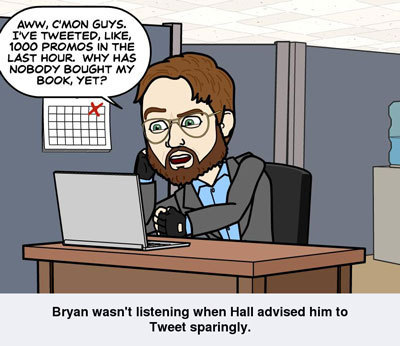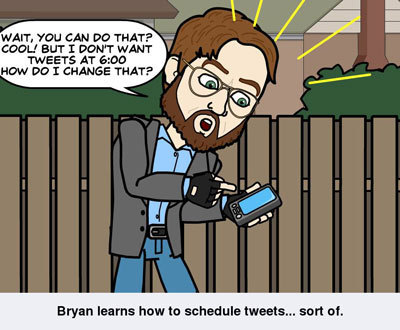Rayne Hall's Twitter for Writers Jump Started My Campaign
I published my latest eBook with low sales expectations, but the reality proved to be far more grim than anticipated. I couldn’t get my friends to buy, my family to buy, much less strangers to buy. I ran Facebook promotions, but nobody nibbled. I went on Goodreads to learn how to find blog sites for reviews, but couldn’t score a single reviewer. I expanded my blogging profile.
I even lined up a marketing firm, but when the rep looked at my platform, she returned my money. “You don’t even have a Twitter presence,” she told me. I’d heard that tune before. If I want to sell my book I need a healthy Twitter campaign.
Unfortunately, I’d tried Twitter before, to promote my fictional cat column Ask Tabby featuring my polydactyl cat Jennymanytoes. It failed miserably. I got a lot of cat followers and saw hundreds of pictures of their cats, but drew no traffic to the blog. (If you’re interested, the real Jenny, no longer with us, had twenty-seven claws.)
Even worse, once I reviewed the marketing contract, I realized my rep only had to return half of my money.
Out of desperation, I decided to try my hand at Twitter again, so I searched the virtual shelves on Amazon and settled on Rayne Hall’s Twitter for Writers . ($2.99 Kindle, Nook and iPad; $0.99 for Amazon Prime members.) Given the amount of money I pissed away on marketing, the price was well within my budget.
Readers who buy Twitter for Writers to promote their books may be frustrated that Hall’s main advice is to not promote their book with their Twitter accounts. At least, do so sparingly. Instead, she walks writers through the steps they need to develop a loyal following who will want to buy their book and continue to follow them in the future.

Hall knows her stuff. With sixty thousand followers and several successful Twitter promotions under her belt, she's well versed on building an audience with faithful followers. Twitter for Writers is no Dummies book. Hall provides a well-paced, well constructed manual for thinking writers determined to build a grounds-up Twitter campaign. Novice and experienced users can start at any chapter and find the advice they need to fashion their strategies.
Twitter for Writers builds on proven formulas, both with her book's chapter structure and realistic expectations for a Twitter platform. The early chapters focus on setting up a Twitter account, eavesdropping and attracting followers. They quickly move through networking, surveys and attracting reviews before finishing with more esoteric topics such as app and account management, scheduling Tweets, fan interaction and online safety. She also covers what writers can do when they reach two thousand followers and Twitter blocks their follower access.

Hall’s campaign formula is simple as well, don’t expect overnight success and expect to put in a lot of hard work.
Hall doesn’t bury readers under technical details. She offers a quick, heads-up read that can be finished in two or three days even with the reader’s browser and Twitter account open in separate windows (as mine were).
Some readers may stumble across aspects of Twitter for Writers that they don’t care for. Hall fills the book with cute cartoons that don’t compete with the New Yorker for quality. Given the low cost of the book and her conversational approach to her readers, I don’t see this as a criticism. However, I recognize that more critical readers might not be so generous. (My son Bryan created these cartoons with Bitstrips.)
She also promotes her own books throughout the pages (books such as Storm Dancer and her series of help books for writers). If readers take umbrage, I might remind them that they probably bought Hall’s book intending to learn how to promote their own. The glass houses metaphor shouldn’t be necessary, but I invoke it nonetheless. If nothing else, readers can use how often she mentions her books as a gauge for how often to Tweet promos for their own.
One thing was clear as I worked through the pages: Hall and a network of fellow writers are committed to nurturing emerging independent authors who are looking to emerge through Twitter. If you follow her advice, you may find yourself engaging in chat with the circle of authors as well (no guarantees). And, yes, once you master the principles in Hall’s you should be able to wisely, sparingly, and hopefully successfully promote your book on Twitter.
Thanks to Twitter for Writers I’m ready to launch my Twitter campaign. My wife Carol, who proofread this for me, laughed when she handed the pages back. “You expect me to believe you’re going to share online when I can’t even get you to share about your morning?”
A man can dream.
Follow or Tweet me @stephens_pt.
I even lined up a marketing firm, but when the rep looked at my platform, she returned my money. “You don’t even have a Twitter presence,” she told me. I’d heard that tune before. If I want to sell my book I need a healthy Twitter campaign.
Unfortunately, I’d tried Twitter before, to promote my fictional cat column Ask Tabby featuring my polydactyl cat Jennymanytoes. It failed miserably. I got a lot of cat followers and saw hundreds of pictures of their cats, but drew no traffic to the blog. (If you’re interested, the real Jenny, no longer with us, had twenty-seven claws.)
Even worse, once I reviewed the marketing contract, I realized my rep only had to return half of my money.
Out of desperation, I decided to try my hand at Twitter again, so I searched the virtual shelves on Amazon and settled on Rayne Hall’s Twitter for Writers . ($2.99 Kindle, Nook and iPad; $0.99 for Amazon Prime members.) Given the amount of money I pissed away on marketing, the price was well within my budget.
Readers who buy Twitter for Writers to promote their books may be frustrated that Hall’s main advice is to not promote their book with their Twitter accounts. At least, do so sparingly. Instead, she walks writers through the steps they need to develop a loyal following who will want to buy their book and continue to follow them in the future.

Hall knows her stuff. With sixty thousand followers and several successful Twitter promotions under her belt, she's well versed on building an audience with faithful followers. Twitter for Writers is no Dummies book. Hall provides a well-paced, well constructed manual for thinking writers determined to build a grounds-up Twitter campaign. Novice and experienced users can start at any chapter and find the advice they need to fashion their strategies.
Twitter for Writers builds on proven formulas, both with her book's chapter structure and realistic expectations for a Twitter platform. The early chapters focus on setting up a Twitter account, eavesdropping and attracting followers. They quickly move through networking, surveys and attracting reviews before finishing with more esoteric topics such as app and account management, scheduling Tweets, fan interaction and online safety. She also covers what writers can do when they reach two thousand followers and Twitter blocks their follower access.

Hall’s campaign formula is simple as well, don’t expect overnight success and expect to put in a lot of hard work.
Hall doesn’t bury readers under technical details. She offers a quick, heads-up read that can be finished in two or three days even with the reader’s browser and Twitter account open in separate windows (as mine were).
Some readers may stumble across aspects of Twitter for Writers that they don’t care for. Hall fills the book with cute cartoons that don’t compete with the New Yorker for quality. Given the low cost of the book and her conversational approach to her readers, I don’t see this as a criticism. However, I recognize that more critical readers might not be so generous. (My son Bryan created these cartoons with Bitstrips.)
She also promotes her own books throughout the pages (books such as Storm Dancer and her series of help books for writers). If readers take umbrage, I might remind them that they probably bought Hall’s book intending to learn how to promote their own. The glass houses metaphor shouldn’t be necessary, but I invoke it nonetheless. If nothing else, readers can use how often she mentions her books as a gauge for how often to Tweet promos for their own.
One thing was clear as I worked through the pages: Hall and a network of fellow writers are committed to nurturing emerging independent authors who are looking to emerge through Twitter. If you follow her advice, you may find yourself engaging in chat with the circle of authors as well (no guarantees). And, yes, once you master the principles in Hall’s you should be able to wisely, sparingly, and hopefully successfully promote your book on Twitter.
Thanks to Twitter for Writers I’m ready to launch my Twitter campaign. My wife Carol, who proofread this for me, laughed when she handed the pages back. “You expect me to believe you’re going to share online when I can’t even get you to share about your morning?”
A man can dream.
Follow or Tweet me @stephens_pt.
Published on January 30, 2015 15:09
No comments have been added yet.
Wind Eggs
“Wind Eggs” or, literally, farts, were a metaphor from Plato for ideas that seemed to have substance but that fell apart upon closer examination. Sadly, this was his entire philosophy of art and poetr
“Wind Eggs” or, literally, farts, were a metaphor from Plato for ideas that seemed to have substance but that fell apart upon closer examination. Sadly, this was his entire philosophy of art and poetry which was that it was a mere simulacrum or copy which had nothing to offer us and was more likely to mislead.
As much as I admire Plato I think the wind eggs exploded in his face and that art and literature have more to tell us, because of their emotional content, than the dry desert winds of philosophy alone. ...more
As much as I admire Plato I think the wind eggs exploded in his face and that art and literature have more to tell us, because of their emotional content, than the dry desert winds of philosophy alone. ...more
- Phillip T. Stephens's profile
- 31 followers



